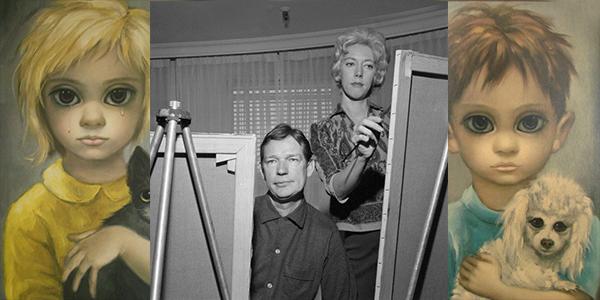Walter Keane was an American artist who became famous in the 1950s and 1960s for painting a series of widely-reproduced images depicting vulnerable children with enormous eyes. His story begins in Berlin in 1946, as a young American Walter was in Europe to learn how to be a painter. It was there that the would-be artist found himself staring quite heartbroken at the big-eyed homeless children fighting over scraps of food in the street. Keane would later write: “As if goaded by a kind of frantic despair, I sketched these dirty, ragged little victims of the war with their bruised, lacerated minds and bodies, their matted hair and runny noses. Here my life as a painter began in earnest”.
By the early 1960s, the artist’s prints and postcards were selling in the many millions; with the great and the good, including Natalie Wood, Joan Crawford, Dean Martin, Jerry Lewis and Kim Novak buying up the originals. Keane had become an art sensation; the student had become a renowned artist and fulfilled his dream – and with money and fame came power, and a hedonistic life-style to suit a film star.
According to the artist’s biographers, Adam Parfrey and Cletus Nelson, Keane was not a reflection of his ‘innocent’ work but a drinker and a lover, of some note – even if this was in fact stated by the artist himself. Keane describes to them in his own words his first meeting with Margaret, the woman who would become the artist’s wife. The words are from Keane’s 1983 memoir, The World of Keane: “I love your paintings,” she told me. “You are the greatest artist I have ever seen. You are also the most handsome. The children in your paintings are so sad. It hurts my eyes to see them. Your perspective and the sadness you portray in the faces of the children make me want to touch them.” – “No,” I said. “Never touch any of my paintings.”
This is a conversation that apparently took place between the two at an art exhibition in San Francisco in 1955. Walter was still an unknown artist at the time, and would not become an art world sensation for another couple of years. Later that night, his memoir continues, Margaret told him: “You are the greatest lover in the world.” They were married that same year.
Yet many years later Walter Keane was accused of lying by his wife; the perpetration in question was that the famous artist’s paintings were in fact her own. In the subsequent slander suit Margaret challenged Keane to a “paint off”, but he declined citing a sore shoulder. Margaret then painted a work of wide-eyed sentimentality before the jurors in a mere 53 minutes and the suit was settled in her favour for £2.5 million.
Yet Margaret never saw a penny of the money; and in the media the case remained disputed. By then the couple were divorced; and a narcissistic Walter had lost his charm inside a bottle; drinking away every cent that was owed to his ex-wife.
The truth of their marriage in fact hid the fraudulent reality of Walter Keane. The couple were happily married for the first two years until Margaret discovered that Walter was selling her paintings as his own; stating that they needed the money, and that people were more likely to buy a painting if they thought they were talking to the artist. According to Walter; people didn’t want to think that he couldn’t paint – and needed to have his wife do it for him. People already thought Walter painted the big eyes and if they suddenly saw it was his wife creating them, the Keane’s would be sued.
The fraudulent artist offered Margaret a solution: she would teach him how to paint the big eyes, and their problem would be solved. But this was impossible – Walter had no skills as a painter – and blamed his inability to learn on the apparent inadequacies of his wife.
So began a ten year period that saw Margaret under house arrest in now luxurious surroundings, paid for by her art – as she painted behind locked doors. The true artist never saw the money – as the bank account was controlled by Walter – who ensured the servants never found out the truth – as he cavorted through his life of debauchery.
But in the end Walter died in 2000. Having eventually given up drinking yet still missing those heady days of wealth and stolen fame, writing in his memoir that sobriety was his “new awakening, away from the drinking world of exciting sexy beautiful women, parties and art buyers”. By the 1970s, the big eyes had fallen out of fashion with a shuddering thud. Even Woody Allen mocked them in his sci-fi comedy ‘Sleeper’, imagining a terrifying future where they were still revered.
Margaret Keane – the real artist behind the work – became a Jehovah’s Witness. She moved to Hawaii where she started painting big-eyed children swimming with tropical fish in azure seas. Yet in the Hawaii paintings a change began to occur to the sad, and trapped big-eyed children of the famous works – the viewer could see slight, cautious smiles begin to form on the faces depicted. They were free -as was the artist.
Now many years after the works fell from favour, new light is being shed on the paintings, and the fascinating story behind them – as one of the biggest art frauds in history – a biopic, ‘Big Eyes’, is about to be released, starring Amy Adams and Christoph Waltz, after the story peaked the fascination of acclaimed director Tim Burton.
So if you look closely enough during one of its many scenes you might see a now elderly Margaret, sitting on a park bench, in a cameo appearance in Tim Burton’s new film – she may even have big eyes, and – a slight smile on her face.

